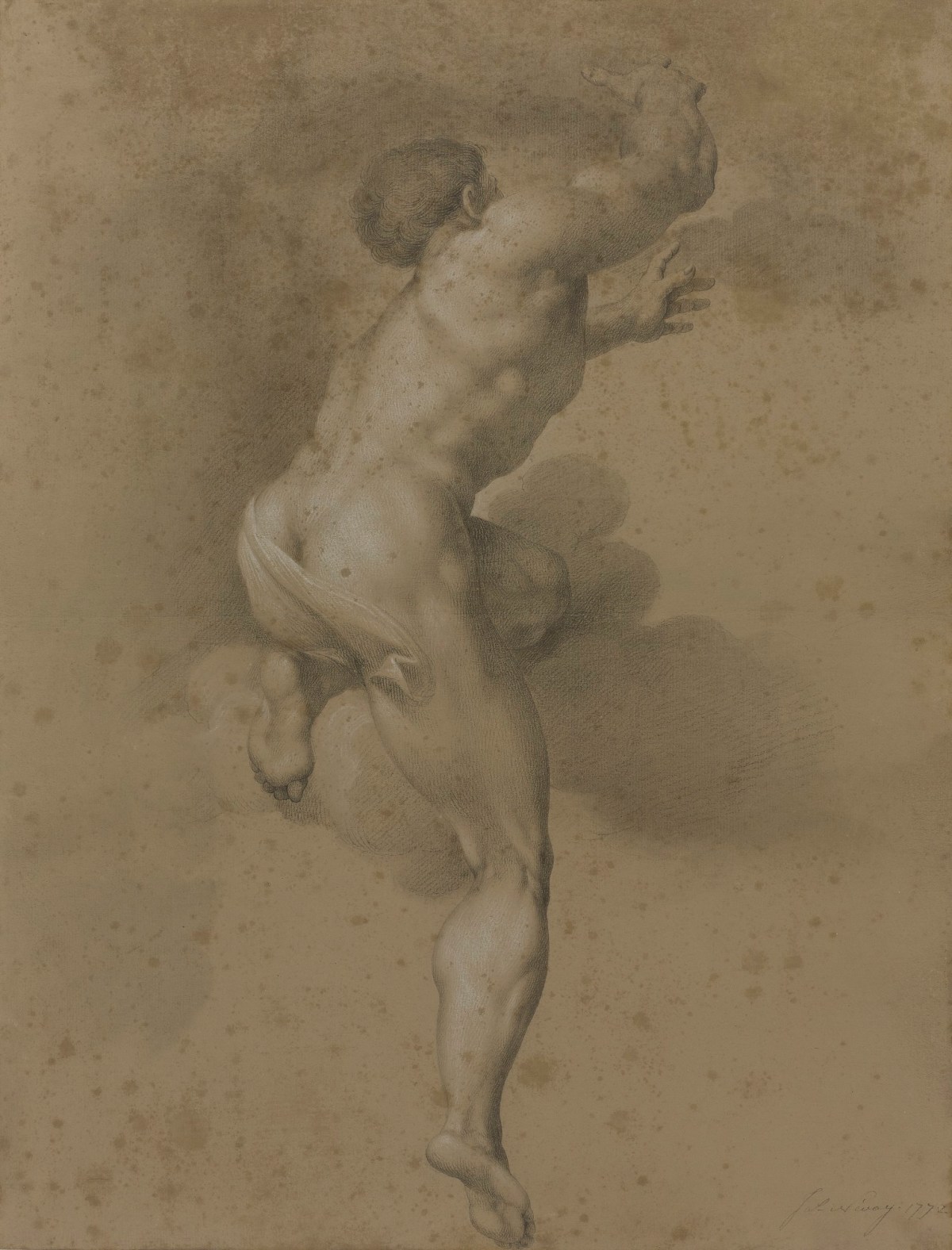
James Nevay, Male nude, after a figure in Michelangelo's 'Last Judgement', 1772.
Pencil and white chalk on buff laid paper. 518 mm x 394 mm. © Photo: Royal Academy of Arts, London.
This image is not available to download. To licence this image for commercial purposes, contact our Picture Library at picturelibrary@royalacademy.org.uk
Male nude, after a figure in Michelangelo's 'Last Judgement', 1772
James Nevay (ca. 1730 - after 1811)
RA Collection: Art
A highly finished pencil drawing, with white chalk highlights, depicting a male nude seen from the back with his right arm stretching upwards as he kneels on his left leg. This figure is a copy of one of The Saved on the bottom left of Michelangelo's Last Judgement fresco in the Sistine Chapel. The dynamic pose depicts the figure making his way towards Heaven. The drawing is carefully worked in curved hatched and cross-hatched lines of pencil, highlighted with white chalk against the light brown of the paper to produce a result almost resembling a print.
James Nevay - also known as Giacomo Nevay - was born in Edinburgh c.1730 but lived in Rome from 1755 onwards. This drawing and three others by him in the RA collection all feature figures copied from Michelangelo's colossal fresco of the Last Judgement in the Sistine Chapel. John Ingamells (see Further Reading) notes that Nevay was known as a talented and precise draughtsman but an exceedingly slow painter. He was engaged in making drawn, engraved and painted copies from Classical and Renaissance works of art in Rome from the late 1750s onwards. In June 1772 Patrick Home commented that he had seen a group of drawings after Michelangelo in Nevay's studio, describing them as 'well done, uncommonly so - great force, and with a free pencil'. This drawing was almost certainly one of the drawings mentioned by Home and also exhibited at the RA Annual Exhibition the following year (Ingamells, p. 701). The artist presented the drawings to the Academy following the exhibition.
The Irish painter James Barry also drew attention to Nevay's drawings after Michelangelo in his 1783 publication An account of a series of pictures, in the great room of the Society of Arts, Manufactures, and Commerce, at the Adelphi : 'But to return to our want of room in the academy; there is not even space enough to hang up those very excellent drawings from M. Angelo's last Judgment (by the able and ingenious Mr. Nevay, at Rome) which have been of so much use to the students in the academy; and if any nobleman or gentleman, was so public sprited as to bequeath us any noted picture, by a leader of the good old schools, where could it be placed, so as to tempt any other to follow the example'. Barry's comments should be read in the context of his campaign for the Academy to establish a comprehensive art collection. The RA Schools, unlike many Continental academies, seem not to have encouraged their students to copy from drawings. Some students nevertheless made use of Nevay's gift, including J. M.W. Turner.
Nevay knew various Academicians who had lived in or visited Rome including Barry, Benjamin West and Henry Fuseli.
Related works:
There are early drawings by Turner after the same figures http://www.tate.org.uk/art/artworks/turner-copy-after-michelangelos-last-judgement-tw1563 http://www.tate.org.uk/art/artworks/turner-study-of-the-lower-half-of-an-ascending-figure-d00196 It seems highly likely that these were made at the RA Schools after Nevay's drawing rather than after a print.
Further reading:
James Barry, An account of a series of pictures, in the great room of the Society of Arts, Manufactures, and Commerce, at the Adelphi, London, 1783, p. 110
John Ingamells, A Dictionary of British and Irish Travellers in Italy 1701-1800, compiled from the Brinsley Ford Archive, Yale, New Haven and London, 1997, pp. 700-701
Object details
518 mm x 394 mm
Associated works of art
3 results
-
![James Nevay, Male nude, after a figure in Michelangelo's 'Last Judgement']()
James Nevay
Male nude, after a figure in Michelangelo's 'Last Judgement', 1772
Pencil and white chalk on buff laid paper
-
![James Nevay, Male nude, after a figure from Michelangelo's 'Last Judgement']()
James Nevay
Male nude, after a figure from Michelangelo's 'Last Judgement', 1772
Pencil and white chalk on buff laid paper
-
![James Nevay, Female nude, after a figure from Michelangelo's 'Last Judgement']()
James Nevay
Female nude, after a figure from Michelangelo's 'Last Judgement', 1772
Pencil and white chalk on buff laid paper
Start exploring the RA Collection
- Explore art works, paint-smeared palettes, scribbled letters and more...
- Artists and architects have run the RA for 250 years.
Our Collection is a record of them.






